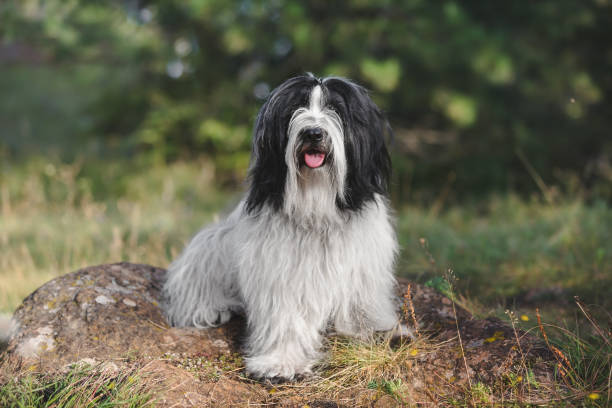Tibetan Terrier

Breed History:
The Tibetan Terrier is an ancient breed that originated in the mountainous regions of Tibet, where it was bred by Buddhist monks in monasteries over 2,000 years ago. Despite its name, the Tibetan Terrier is not a true terrier but was given the name by Westerners due to its size and resemblance to terriers.
Known as the “Holy Dog of Tibet,” Tibetan Terriers were considered good luck charms and were often given as gifts, never sold. They were valued for their loyal companionship, agility, and surefootedness, often assisting herders and acting as watchdogs in the rugged Himalayan terrain. The breed was introduced to the West in the 1920s by Dr. Agnes Greig, a British doctor living in India.
Height: 35-41 cm
Weight: 8-14 kg
Size – Medium
Life Expectancy: 12–15 years

Breed Appearance:
The Tibetan Terrier has a sturdy, square build with a luxurious double coat that can be wavy or straight. One of its most distinctive features is its large, flat, snowshoe-like feet, which help it navigate snowy, mountainous terrain with ease.
Its head is strong and well-balanced, with a fall of hair that often covers its large, dark eyes. The tail is well-feathered and curls over the back. Coat colours vary widely, including white, gold, black, brindle, silver, cream, and tricolour, often with markings.
Breed Type – Companion/Watchdog:
The Tibetan Terrier is a devoted companion dog, combining a gentle temperament with a strong sense of alertness. Historically used as a watchdog and herding assistant, it is deeply loyal and forms strong bonds with its family.
It is friendly but reserved with strangers and makes a good watchdog without being aggressive. This breed thrives in homes where it receives attention, affection, and regular companionship.

Training:
Tibetan Terriers are intelligent and responsive, though they can also be independent and a bit willful, especially if training is repetitive or harsh. They do best with positive reinforcement, praise, and food rewards.
Early socialisation and obedience training are essential to avoid shyness or stubborn behaviour. Their intelligence and desire to please make them capable in agility, rally, and obedience competitions when trained consistently.
Health & Care:
Generally a healthy breed, but like many purebred dogs, the Tibetan Terrier can be prone to specific genetic issues, including:
-
Progressive retinal atrophy (PRA)
-
Hip dysplasia
-
Lens luxation
-
Hypothyroidism
Responsible breeders conduct health screenings to reduce risks. Regular vet checkups, a balanced diet, and proper exercise help maintain overall wellness.

Living Conditions:
Tibetan Terriers are well-suited to both apartments and houses, as long as they receive sufficient daily activity and attention. They adapt well to indoor life and prefer to be close to their people, making them ideal for families and singles alike.
They tolerate cool climates well due to their thick coat, but may struggle in hot, humid environments without proper cooling and grooming.
Exercise:
This breed has moderate energy levels and enjoys a mix of daily walks, indoor play, and occasional off-leash time in a secure area. 30 to 60 minutes of activity per day keeps them fit and mentally satisfied.
They enjoy interactive games, training sessions, and may excel in canine sports like agility and rally. Despite their endurance, they are also content to relax after a good walk or play session.
Grooming:
Tibetan Terriers have a dense double coat that requires regular care to prevent matting. Brushing 2–3 times per week is essential, and daily grooming may be necessary for long-coated dogs.
Many owners choose to trim the coat to a manageable length. Bathing every 4–6 weeks, regular ear cleaning, nail trimming, and dental care are also important. Their coat is naturally non-shedding, but dead hair needs to be manually removed through brushing.

Advantages:
-
Loyal and affectionate with family
-
Excellent watchdog without aggression
-
Adaptable to various living situations
-
Non-shedding coat—better for allergy sufferers
-
Intelligent and capable in dog sports
-
Strong, hardy breed with ancient lineage
Disadvantages:
-
Coat requires frequent grooming to prevent mats
-
Can be shy or reserved without early socialisation
-
May be stubborn or independent in training
-
Needs mental stimulation to avoid boredom
-
Can develop separation anxiety if left alone too long
-
Sensitive to heat due to dense coat

